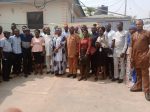Social Protection & Social Investments
•Continue from last edition
As far back as 2004, before the emergence of Ogbeni Aregbesola as the governorship candidate of the Action Congress (AC), he had produced a green book titled ‘My pact with the people’. This pamphlet contains the Six Point Integral Action Plan that formed the philosophy of his administration. The six points are:
· Banish Hunger
·Banish Poverty
·Banish Unemployment
·Promote Healthy Living
·Promote Functional Education
·Promote Communal Peace and Progress
A detailed look at the Six Integral Action Plan would reveal that they are inherently social welfare and protection focused in nature. They are reminiscent of the Action Group (AG)’s welfarist government in the old Western Region and its ‘Freedom for all, life more abundant’ slogan. It is noteworthy at this point that the major policies and programmes of the administration have their essential source from the book. These six points are defined as integral because the delivery of the development vision requires a combined implementation of each of these points.
The Ogbeni Rauf Aregbesola government has robustly designed and continued to faithfully implement its innovative social welfare and protection programmes, spread across the different Ministries, Departments and Agencies (MDAs) and sectors, targeting the neediest sectors of the population including women, children and the elderly.
Impacts.
· In 7 Years, Osun has lifted 406,305 people out of unemployment according to NBS data. Osun unemployment rate reduced by 69% between 2010 and 2017
1.National Bureau of Statistics: National Manpower Stock and Employment Generation Survey (2010)
2.National Bureau of Statistics: Labour Force Statistics Vol. 1: Unemployment and Underemployment Report (Q1-Q3, 2017)
·According to Oxford Poverty and Human Development Institute (OPHI) 2017 report , the incidence of poverty for the State of Osun is 10.9% in Nigeria in 2017 as against 37.5% in 2010 being the second lowest in the country.
·It is important to state that the Misery Index released in Januray2018 by independent research firm, Financial Derivative Company Limited, Lagos in which Osun was equally ranked second lowest (35.36%) has corroborated the Osun ranking in poverty index by OPHI
·The Ogbeni Rauf Aregbesola’s administration through his social investments and social protection programmes has empowered at least 150,000 youths with different skill acquisition and vocational trainings in the state. Many of these youths have now established their businesses after the training and have also engaged extra hands in the management of their ventures.
·The other initiatives of the Ogbeni Rauf Aregesola’sadministration have resulted in the creation of sustainable employment opportunities and enduring capacity development for the teeming population of youths in Osun. It has equally improved livelihoods for the beneficiaries who were supported to grow their businesses and incomes and have therefore created about 200,000 direct and indirect jobs for the teeming population of youth in Osun.
·The OMEALS has served both the primary and secondary beneficiaries. The programme has also created avenue for the people of Osun to move into the production of some of food items being consumed under O-MEALs programme.
1.National Bureau of Statistics: National Manpower Stock and Employment Generation Survey (2010)
2.National Bureau of Statistics: Labour Force Statistics Vol. 1: Unemployment and Underemployment Report (Q1-Q3, 2017)
Summary of Poverty, Human Development Index and Unemployment Rate for Osun
1. Poverty and Vulnerability
2010: The poverty index for the State of Osun was 37.5%, the lowest in the country – National Bureau of Statistics National Poverty Rate for Nigeria 2009-10.
2016: The poverty index for the state of Osun reduced from 37.5% in 2010 to 17.5% in 2016, the lowest in the country – UNDP/NBS Human Development Index Report released in October 2018.
Osun ranked the second less miserable and poverty-ridden state with a misery index of 35.56% in 2017 – The Misery Index Report released in January 2018 by independent research firm, Financial Derivative Company Limited, Lagos
The incidence of poverty for the State of Osun is 10.9% in 2017 being the second lowest (after Lagos) in the country – Oxford Poverty and Human Development Institute (OPHI) 2017 Report.
2. Unemployment
2010: Unemployment rate in Osun in 2010 was 17.2%, the 27th highest in the country – National Bureau of Statistics: National Manpower Stock and Employment Generation Survey (2010)
2017: Unemployment rate for Osun reduced from 17.2% in 2010 to 5.3% in 2017, the 2nd lowest in the country – National Bureau of Statistics: Labour Force Statistics Vol. 1: Unemployment and Underemployment Report (Q1-Q3, 2017)
3. Human Development Index
2013: Human Development index for the State of Osun was 0.4938 in 2013, the 9th highest in the country – UNDP Human Development Index Report 2015.
2016: Human Development index for the State of Osun increased to 0.5123 in 2016 – UNDP/NBS Human Development Index Report released in October 2018.
·The supports given to farmers’ cooperative societies have attracted a lot of people to venture into agricultural production. At least, 28,000 farmers have been supported and empowered through various agricultural support programmes carried by the Ogbeni Rauf Aregbesola’s administration and now earning their livelihoods from farms.
·In addition to creating over 12, 000 jobs, the road projects have also improved conditions for economic growth. There has been quite marked and sharp increase in land prices along the corridors of the road projects thereby encouraging poor households who had considered their land holdings worthless to convert the land into economic benefits in the light of current realities occasioned by the road construction projects.
·The rural road construction has opened up new areas for agricultural activities and also made it easy for about 20,000 farmers to transport their produces from farms to the markets thereby improving the income and livelihood of poor farming households. The Osun land bank programme has provided access to land to over 10,000 farmers including small, medium and large -scale farmers. Similarly, electrification projects at the rural communities have also opened new window of opportunities for the rural population to carry out value-addition processes for their produces.
·The implementation of social protection programmes has promoted social inclusiveness and equitable access to services in the State.
·The World Bank has adopted the OYES initiative as a model for its Youth Empowerment and Social Support Operation (YESSO) and the concept is being replicated in 18 states
·The OYES model has also been adopted by the Federal Government of Nigeria in designing and implementing N-power programme under its National Social Investment Programme being implemented through the Office of the Vice President.
·Most of Osun innovative Social Protection Programmes have served as template for similar programmes at the federal or national level.
·Reduced level of poverty and vulnerability in Osun as evidenced by the reduction of incidence of poverty of the state from 37.5% in 2010 to 10.9% in 2017
·The implementation of social protection programmes has promoted social inclusiveness and equitable access to services in the State
·Summing up all the efforts of the Ogbeni Rauf Aregbesola’s administration, we can reliably state that the government has lifted over 700,000 people out of poverty in Osun within a period of 7 years.
Innovative programmes executed under Ogbeni Rauf Aregbesola’s Administration in Social Protection and Investment Sector
Osun Elementary Schools Feeding and Health Programme (O-MEALS)
· Over 254,250 in grade 1-4 in 1382 public elementary schools being fed daily
· Over 305 million plates of food have been served under OMEALs between 2012 and 2018 at the cost of ¦ 10 billion
· Over 1.5 million pupils have benefited from OMEALS between 2012 and 2018
·OMEALS employs 3,007 caterers across the state
·900 cocoyam farmers, 700 small poultry farmers, 310 catfish farmers and 63 cow markets all in Osun food items to OMEALs caterers
·School enrollment increased from 155,318 pupils at inception to 252,739, representing a 62% increment in enrollment
·Under OMEALs, Osun pupils consumed 8,400 crates of eggs are consumed weekly, 336,000 crates are consumed annually, over 2 million crates of egg over the past 6 years
·10 metric tons of catfish is consumed weekly; 400 tonnes of fish is consumed annually, over 2.4 million tonnes consumed over the past 6 years
·35 heads of cows are slaughtered for consumption per week, 1,400 heads of cows are slaughtered for consumption annually, over 8,400 heads of cows consumed
·15,000 broiler chickens are consumed per week, over 3.6 broiler chicken have been consumed under OMEALs in the past 6 years
·Over 305 million plates of food have been served under OMEALs for the cost of ¦ 10 billion
·Over 25 States including federal offices have visited Osun to understudy the implementation of OMEALs
Osun Youth Empowerment Scheme (OYES)
·Over 74,108 youth volunteers recruited, trained and deployed under the scheme
·8,000 cadets deployed as teachers in public primary and secondary schools, 6,000 of whom were subsequently hired as permanent teachers
·50 cadets sponsored to travel to Germany to acquire advanced farming skills
·10,000 cadets trained as information communications technology (ICT) specialists at the RLG/Adulawo technology city in Ilesa – OYESTECH
·150 OYESTECH graduates sent to Ghana for further training
·45 cadets employed as bus drivers for Omoluabi Scholar Bus Scheme
·31 cadets trained in mechatronics, a multidisciplinary field of engineering, in Germany
·Over 1,000 OYES Cadets empowered as caregivers for Agba Osun beneficiaries
·Over 300 Youths engaged as agro dealers under Farmers Input Supply Scheme
·Over 1,000 youths trained in participatory rural appraisal programme
·45 Cadets employed as bus drivers for Omoluabi Scholar Bus Scheme
·31 youths trained in Mechatronics (multidisciplinary field of engineering with focus on mechanical, electrical, telecoms, control and computer engineering) in a train-the trainer project in Lucas Nulle in Kerpen Germany.
·OYES adds an extra N200million every month to the Osun economy
·10,000 monthly allowances paid to volunteers
·2,806 Cadets trained in modern agriculture at O-REAP Academy, Odua Farmers’ Academy and Leventis Foundation
·Over 1,600 youths empowered in the agric enterprise academy, O-REAP Youth Academy located in the 9 federal constituencies for increased food production and empowerment.
Free Ambulance Service (O-Ambulance)
·50 ambulances were procured to provide round the clock emergency services to residents of the state in distress during accidents or other emergency needs with 404 paramedics employed and trained.
·14,675 persons consisting of 9245 males and 5430 females have been rescued from roads, sickness since 2013.
Osun Destitute Rehabilitation Programme (O-REHAB)
·173 mentally derailed individuals picked from the streets treated.
·2,664 destitute rehabilitated.
Osun Micro-credit
·Over 25,000 SMEs accessed no-interest Osun micro-credit.
Agba Osun
·1602 vulnerable aged persons being given monthly ¦ 10,000 grant and assigned care giver for their medical care
Office of the Public Defender and Citizens’ rights (OPD)
·The OPD established in 2013 has rendered free legal services to over 1,209 beneficiaries who could not afford legal fees.
Multi Birth Parents
· Over 11 multiple birth parents have been supported with cash and kind donations.
Osun Land Bank Programme
·Over 30,000 smallholder farmers have been given access to land for agricultural production
Social Protection Study Tour to Osun
Over 140 top government officials from 17 states and all UNICEF Field Offices in Nigeria visited Osun in 2017 to understudy the wide range of social protection programmes being implemented by State Government of Osun and draw lessons to inform policy intervention in other places.
•To be continued










